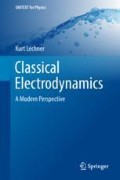Abstract
In this chapter we perform a case study of the electromagnetic radiation generated by a straight infinite conducting wire, carrying a generic homogeneous time-dependent current I(t). Being an infinitely extended physical system, a straight wire represents a prototypical unbounded system of electric charges, entailing a four-current which has at each time a non-compact spatial support. The physical properties of the electromagnetic field produced by an infinite wire are, therefore, expected to differ substantially from the general properties of the fields created by compact charge distributions – typically a single charged particle, or a system of charged particles confined to a bounded region – analyzed in detail in Chaps. 6–8. On the other hand, a current flowing in a straight wire possesses cylindrical symmetry, as does the charged particle in linear motion originating the Čerenkov effect. This peculiar geometrical feature allows for a close comparison of the physical and mathematical aspects of the electromagnetic fields generated by the two systems. Below we anticipate the main similarities and differences.
Access this chapter
Tax calculation will be finalised at checkout
Purchases are for personal use only
Notes
- 1.
We make here the far-from-obvious assumption that the index of refraction \(n(\omega )\) maintains its physical meaning also for \(\omega \rightarrow 0\).
- 2.
As we supposed I(t) to be continuous, the current \(\varDelta I (t)\) at \(t=0\) entails the finite discontinuity \(I_a-I_b\). However, we will see that the latter is easier to handle than the overall variation \(I_b-Ia\) of the current I(t) between \(t=-\infty \) and \(t=\infty \).
- 3.
- 4.
Actually, for the bound \(|I_N|<b/N^2\) to hold, it is sufficient that the current I(t) is absolutely continuous and admits a piecewise absolutely continuous first derivative \(\dot{I}(t)\).
- 5.
Since the spatial coordinate \(\mathbf {x}\) is a mere spectator, it is sufficient to consider the one-dimensional distribution space \(\mathcal{S}'=\mathcal{S}'(\mathbb {R})\) relative to the time coordinate.
References
M. Reed, B. Simon, Methods of Modern Mathematical Physics - I Functional Analysis (Academic Press, New York, 1980)
W. Rudin, Functional Analysis (McGraw-Hill, New York, 1991)
K.R. Stromberg, Introduction to Classical Real Analysis (Wadsworth International Group, Belmont, 1981)
L. Carleson, On convergence and growth of partial sums of Fourier series. Acta Math. 116, 135 (1966)
Author information
Authors and Affiliations
Corresponding author
Rights and permissions
Copyright information
© 2018 Springer International Publishing AG, part of Springer Nature
About this chapter
Cite this chapter
Lechner, K. (2018). Radiation from an Infinite Wire. In: Classical Electrodynamics. UNITEXT for Physics. Springer, Cham. https://doi.org/10.1007/978-3-319-91809-9_14
Download citation
DOI: https://doi.org/10.1007/978-3-319-91809-9_14
Published:
Publisher Name: Springer, Cham
Print ISBN: 978-3-319-91808-2
Online ISBN: 978-3-319-91809-9
eBook Packages: Physics and AstronomyPhysics and Astronomy (R0)

